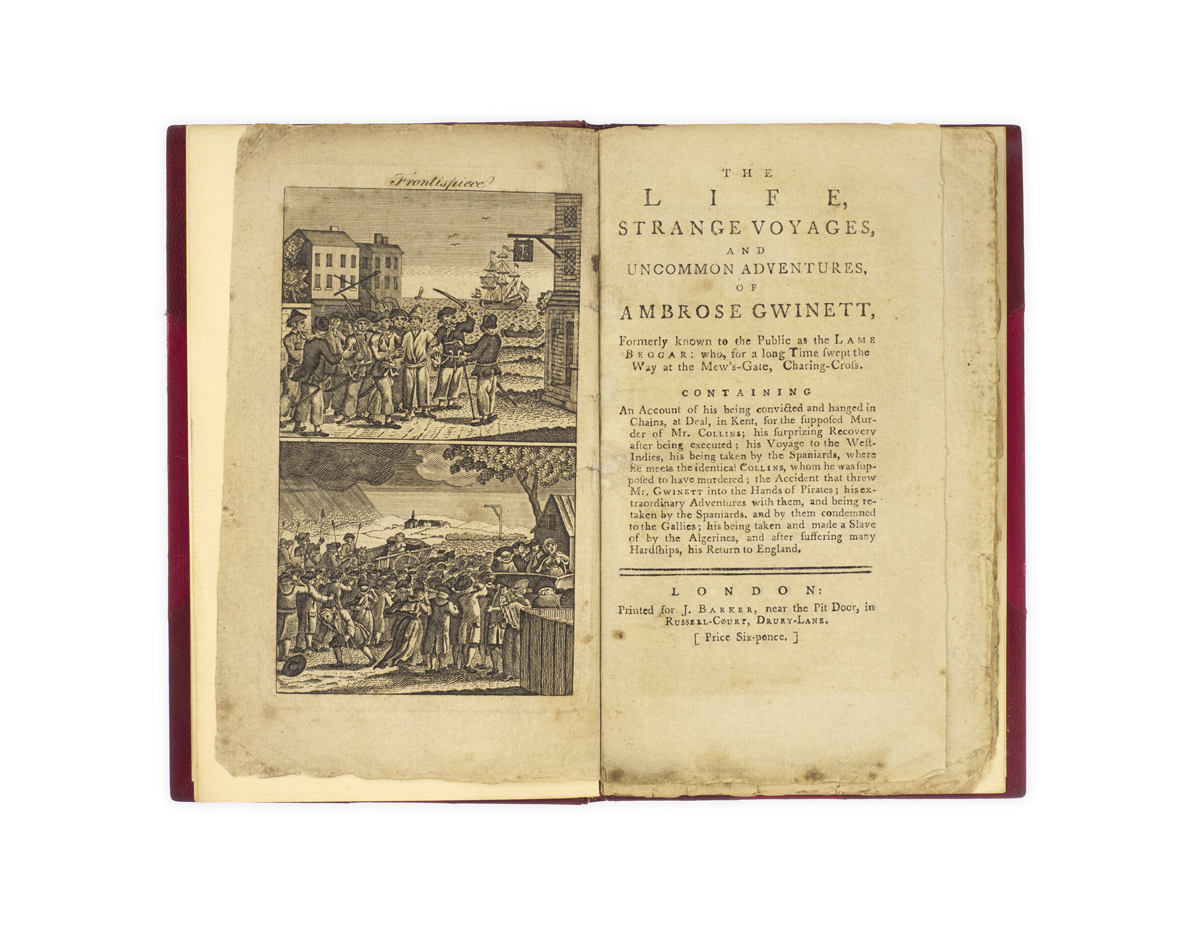
Bruce’s great expedition, shortened
BRUCE, James.
Travels, between the years 1765 and 1773, through part of Africa, Syria, Egypt, and Arabia, into Abyssinia, to discover the source of the Nile: comprehending an interesting narrative of the author’s adventures in Abyssinia, and a circumstantial account of the manners, customs, government, religion, history, &c. &c. of that country, being the substance of the original work ...
London, James Robins and Co. Albion Press, [1820?].
8vo, pp. xv, [1 (blank)], [17]-486, [2]; with portrait frontispiece (dated 1820), additional engraved title, and 9 engraved plates; some foxing and browning throughout; nevertheless good in recent half black leather over marbled boards, spine lettered in gilt; ‘J.B. Burroughs’ in pencil at head of title.

Added to your basket:
Travels, between the years 1765 and 1773, through part of Africa, Syria, Egypt, and Arabia, into Abyssinia, to discover the source of the Nile: comprehending an interesting narrative of the author’s adventures in Abyssinia, and a circumstantial account of the manners, customs, government, religion, history, &c. &c. of that country, being the substance of the original work ...
First edition thus, an abridged account of James Bruce’s famous travels through Ethiopia on a quest to discover the source of the Nile.
‘Bruce arrived at Alexandria in June 1768 and while there became determined to undertake a journey in search of the source of the Nile. With his companion Luigi Balugani, he ascended the Nile delta to Cairo, then to Aswan where his path was blocked by a local feud. After returning to Qus, he crossed the desert to Cosseir (= Quseir) from where, disguised as a Turkish sailor, he reached Jiddah (May 1769) by way of Sinai and Yanbu (=Yanbu’al Bahr). Continuing down the Red Sea by way of Al Luhayya, on 19.9.69 he reached the port of Massawa (in Ethiopia), at that time in the hands of the Turkish. With a party of twenty men Bruce struck inland in November 1769 to Adowa (= Aduwa) and then to Axum (= Aksum) and Gondar (14.2.70), where Balugani died. Given command of a troop by Ras Michael he proceeded around the western shore of Lake Tana, and to the Tisisat Falls on the Blue Nile (= R. Abbai). Returning slightly to the west, he ascended the Little Abbai, a feeder of Lake Tana from which most of its water flows, to its source at Geesh (14.11.70)’ (Howgego). Bruce stayed in the region for about a year. In December 1771 he ascended the Blue Nile – where he spotted the larger stream of the White Nile – before crossing the desert to Aswan and returning to Cairo, dressed as a beggar, in January 1773. As Pankhurst notes, Bruce ‘ranks among the world’s great travellers’.
Bruce first published an account of his travels some fifteen years after his return, in 1790, in five gargantuan volumes. In London, his stories were often regarded as fabulous: ‘long after his death – for forty years at least – his book was believed by many people to be romantic fiction, and critics continued to attack it ... [but] men like Browne and Burckhardt, began to discover that Bruce, far from being a romancer, was a most reliable guide. Little by little they got through the embroideries of his book to the heart of the story he had to tell, and they found it astonishingly sound’ (Alan Moorehead, The Blue Nile pp. 48–9).
This edition was published more than 25 years after Bruce’s death. It is based on and abridged from Bruce’s revised version of his Travels, which was first published, in seven octavo volumes, in 1805. The publication of the abridgement appears to have been motivated not only by the desire to offer Bruce’s account in a condensed (and therefore more affordable) format, but also by the need to offer the public some more information about the country of Ethiopia at a time when Britain was engaged in ‘the purpose of attempting to open friendly relations with that country’ (p. iv).
Howgego B171; Ibrahim-Hilmy I p. 91; Pankhurst 10.

